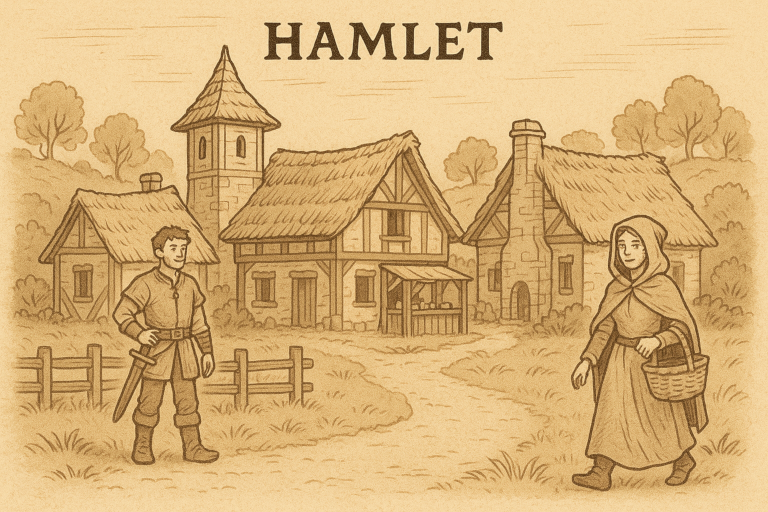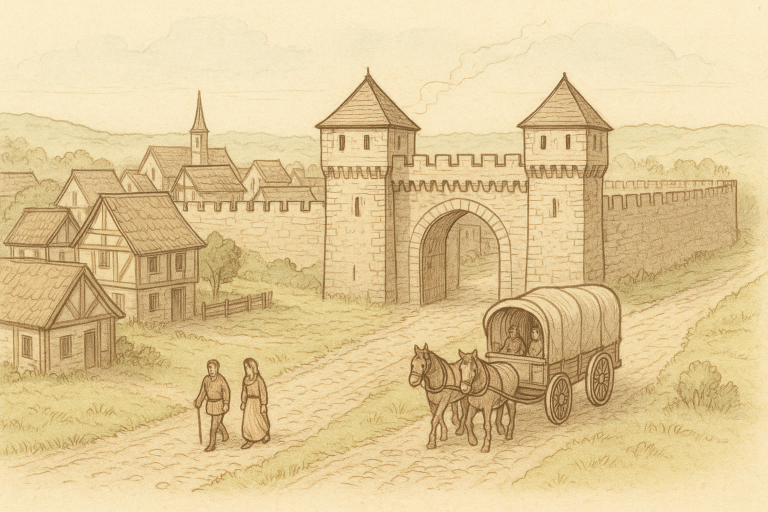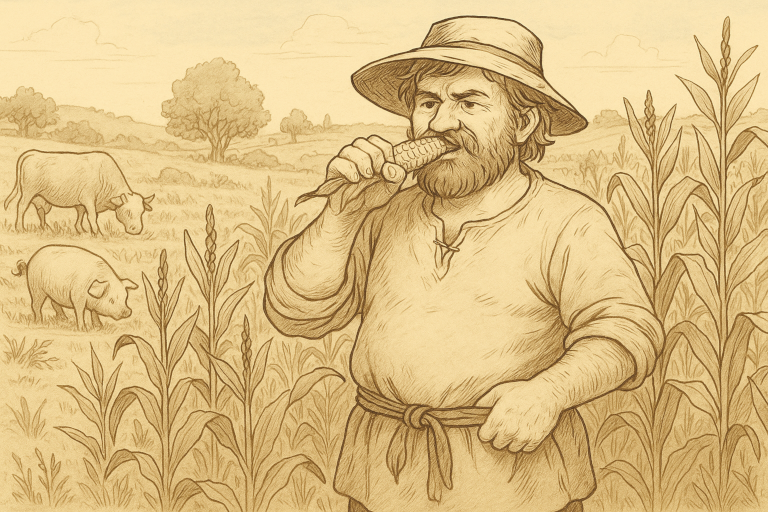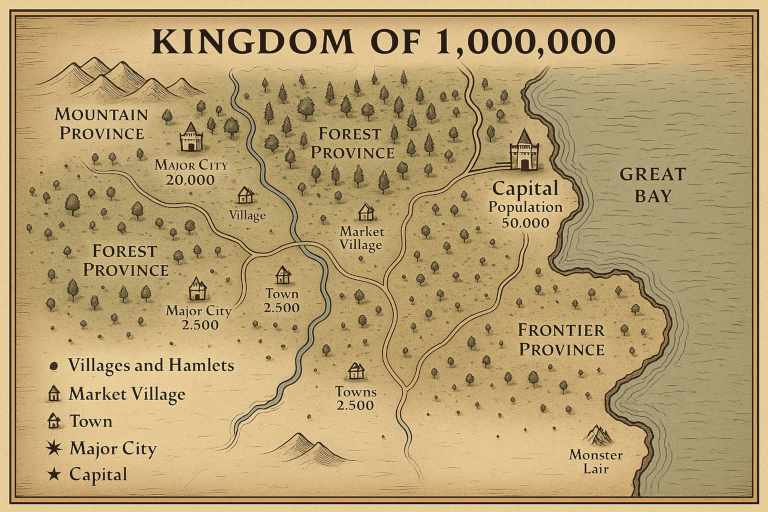Table of Contents
Creating a believable medieval kingdom for a campaign requires more than castles, dungeons and monsters. A compelling setting is grounded in a realistic socio-economic structure, which includes understanding historical demographics, trade networks, and how many people are needed to sustain various professions. Let’s dive into the foundations of building a thriving, immersive kingdom using historical data and a touch of fantasy.
Population and Settlement Structure
Medieval populations were primarily rural – that is based upon Western European and most Eastern European societies, hence the scale of settlements can vary greatly depending on the setting’s technological level, geography, and access to trade routes. Across the world there were significant exceptions to the European “norm” – especially large city states sitting across rich trade routes as well (as in European terms) massive empires with cities the size of which a medieval European could not imagine. Here’s a general breakdown of population ranges in historical terms, adapted for fantasy worldbuilding:


- Hamlet (20–100 people): These are tiny clusters of homes, often little more than extended families or a few farming households. They usually lack a church, inn, or blacksmith. A local reeve or elder may be the only leadership figure.
- Village (100–800 people): Villages are the most common rural settlement, often centered around a manor or farming community. A village might support a blacksmith, a miller, and a small shrine or temple.
- Town (1,000–5,000 people): Towns are hubs of trade and craft. They typically have walls, markets, a mayor or reeve, several inns, and a variety of artisans. Towns may form around river crossings, crossroads, or ports.
- City (5,000–25,000 people): Cities are centers of power, commerce, and religion. They support multiple guilds, temples, mercenary companies, and often have a noble seat or regional governor.
- Great City/Capital (25,000+): Rare even in medieval times, cities of this size were often capitals or major trading ports. Think Constantinople or Paris. These can support universities, cathedrals, large standing armies, and bustling marketplaces with exotic goods.
As a rule of thumb, about 90% of a kingdom’s population will be rural (hamlets and villages), with only 10% in urban centers.
Population Support per Trade
In a pre-industrial society, many trades require a minimum number of people to sustain them. The “occupational density” model helps determine which services and crafts are available in a given location. Here are some estimates, historically inspired but adaptable for fantasy:
- Farmer – 1 per 5 people: Most people are involved in food production.
- Miller – 1 per 250 people: Needed for processing grain.
- Blacksmith – 1 per 200 people: Essential for tools, horseshoes, and weapons.
- Clothier/Weaver – 1 per 150 people: Provides clothing and textiles.
- Baker – 1 per 250 people in urban centers.
- Cobbler – 1 per 200–300 people.
- Priest/Cleric – 1 per 100 in villages; more in cities with large temples.
- Tavern Keeper/Innkeeper – 1 per 150 people, more if near roads or markets.
- Merchant/Trader – 1 per 100 in cities and towns; may visit villages weekly.
In fantasy settings, you can adapt this by layering in magical professions:
- Alchemist – 1 per 2,000+: Rare and expensive, usually in major cities or near universities.
- Wizard/Enchanter – 1 per 5,000+: Often tied to guilds, towers, or courts.
- Healer/Herbalist – 1 per 500–1,000: Often replaces or supplements mundane medical care.
- Monster Hunter or Adventurer’s Guild – 1 per 2,000+: These might only thrive in frontier towns or large cities.
These numbers help you populate your towns with realistic services and make settlements feel alive. Remember in small hamlets and villages many of these trades will be carried by one or multiple people on a part time basis. Families will farm, mill, bake and weave. Blacksmithing may be carried out by one or two people as needed. Naturally in these circumstances the quality (and type) of what is produced will likely be far less than in a town or city.

Trade and Economy
Medieval kingdoms relied on a mix of barter and coinage, with most rural areas self-sufficient. However, towns and cities functioned as trade hubs, allowing specialization. Key industries might include:
- Agriculture and Animal Husbandry – The backbone of every settlement. No food equals famine which equals immigration, riots, wars. Kingdoms have been levelled by lack of food.
- Mining and Smithing – Essential for arms, armor, and trade goods. If your kingdom is rich in smithed goods, where does it get its ore from? Is the coal, iron or copper it relies on coming from a single province or neighbouring kingdom which could cause issues – and also potential plot hooks for adventure!
- Fishing and Salt Production – Vital in coastal or riverine areas. Don’t underestimate the importance of salt! Meat and fish would be salted in order to preserve it. It was such a valuable resource that nobles may regulate it or hold a monopoly. Wars have been fought over less.
- Lumber and Carpentry – Needed for ships, homes, wagons. Burnt for charcoal, shaped for bows. Crafted for handles for everything from farming tools to weapons of war.
- Textiles – Linen, wool, and later, imported silk. Woollen goods need sheep (or something like alpacas). Cotton requires cotton crops. Duh.
- Magic Goods (Fantasy) – Scrolls, potions, magical services; regulated or black market? Imported or locally produced. What is needed to support the services? Are there specific resources needed?
Most villages produce local surplus (grain, wool, livestock) and trade with nearby towns for salt, iron tools, or finished goods. Cities become export centers and control currency minting, tariffs, and trade laws.
Designing the Kingdom
When creating your kingdom, start with a capital or central city, then spread out to provincial cities, towns, and villages. Consider:
- Geography (rivers, mountains, coasts)
- Road networks and trade routes
- Political structure (monarch, council, guilds)
- Key resources and industries
- Conflict (monsters, rival kingdoms, rebellions)
A kingdom with 1,000,000 people might have:
- 1 capital (50,000)
- 3 major cities (20,000 each)
- 10 towns (2,000–5,000)
- 200+ villages
- Countless hamlets and isolated farms
Conclusion
A well-designed medieval kingdom makes your campaign world feel immersive and alive. By grounding your setting in historical realism and blending in fantasy elements, you create a realm that not only feels authentic but also gives players logical, interconnected spaces to explore. Whether it’s a bustling city market, a dusty village crossroads, or a lone alchemist in a tower, every part of your kingdom can tell a story—if you build it thoughtfully.
But keep in mind that you don’t need to create the whole kingdom at once. If you are setting your campaign in a specific city or region, then focus on that. Leave the rest of the kingdom as fairly unknown – maybe define the names of the largest cities or towns outside of where the players will be, but you don’t need to spend the time developing them in detail.
Better to spend the time on an individual area and give it depth. If your players are travelling great distances, then small towns and hamlets become generic undefined places that blur in their memory and are forgotten. Not something you would wish for if you had laboured hours in creating a fantastic town only to have the players pass through in 1 minute of game time.
Also keep in mind that at the end of the day this is your world and how it is structured and how it is laid out is your decision. There are no right or wrong decisions, although possibly the only judge is how enjoyable it is to your players.
Population Planner
Here’s a Population Planner—a simple, logical tool to help you calculate the structure and population of your kingdom. This planner is based on historical ratios and adapted for fantasy settings. You can tweak the numbers to match your world’s level of magic, technology, and density.

Step 1: Set the Total Kingdom Population
Choose a total population for your kingdom based on your world’s scale.
| Kingdom Size | Approximate Population |
| Small Barony | 50,000 |
| Modest Duchy | 200,000 |
| Large Kingdom | 1,000,000 |
| Empire | 5,000,000+ |
Let’s assume 1,000,000 people for this example.
Step 2: Settlement Distribution (Historical 90/10 Rural/Urban Split)
🔹 Rural (90% = 900,000)
| Type | People/Settlement | Number of Settlements |
| Hamlet | 50 | 8,000+ (scattered, not worth naming except in rare occasions) |
| Village | 400 | 1,500 (tend to be on or near roads. Only worth naming in rare occasions) |
Not all rural dwellings are part of a named village; some are isolated farms or estates. These places are so small that unless they are a critical part of your campaign they are not worth naming or fleshing out
🔹 Urban (10% = 100,000)
| Type | Avg Pop | Number | Notes |
| Capital | 50,000 | 1 | Administrative, religious, or magical hub |
| Major Cities | 20,000 | 2 | Trade and regional centers |
| Towns | 2,500 | 10 | Local commerce, minor military |
| Large Villages/Market Towns | 1,000 | 10 | Transition zones between rural and urban |
This excludes things like bastions, castles, evil lairs etc.
Step 3: Occupational Distribution Estimates
Use these to calculate how many professionals your settlements can support.
📜 Common Trades
| Trade | People per 1 | Number in 1,000,000 Kingdom |
| Farmer | 5 | 200,000 |
| Miller | 250 | 4,000 |
| Blacksmith | 200 | 5,000 |
| Cleric/Priest | 100 | 10,000 |
| Tavern Owner | 150 | ~6,600 |
| Healer | 500 | 2,000 |
| Merchant | 100 | 10,000 |
| Weaver | 150 | 6,600 |
| Baker | 250 | 4,000 |
| Guards/Watch | 100 (urban) | ~10,000 total in cities |
🧙♂️ Fantasy Additions
| Trade | People per 1 | Number |
| Alchemist | 2,000 | 500 |
| Wizard/Sage | 5,000 | 200 |
| Enchanter | 10,000 | 100 |
| Monster Hunter | 2,000 | 500 |
| Adventuring Guild | Town+ only | 10–20 chapters |
There are many, many other trades but these are the ones you might want to consider in your campaign as possible NPC interactions.
Step 4: Visualize the Kingdom
- Draw a rough map of your kingdom. Highlight major terrain features such as mountain ranges, major forest or other significant obstacles.
- Create provinces or regions by breaking your map into sections. Regions can be bounded by terrain features. Rivers and mountains make great natural boundaries both to the kingdom but also regions.
- Work out the trade routes these typically will be main entry/exit points to and from your kingdom to other kingdoms. Large towns, cities or even the capital is likely to be positioned at a point where trade routes cross as these make potentially high-income locations
- Place the capital near a river, coast, or trade crossroad. Somewhere that makes sense. If it’s near the edge of the kingdom then is it open to capture in the event of war? Think about the rules and where they would want to live in your kingdom.
- Distribute cities evenly across provinces or regions. Some regions may be poorer than others so some regions may only have small cities.Think about the trade and military situation in the kingdom and where bigger cities would make sense.
- Connect settlements via major roads; build villages along rivers and trade routes. Don’t draw every track and path. Just focus on the main ones that make sense.
- Add resource nodes: mines and forests. These don’t need to be in detail. Most mining in the world takes place in specific areas, not just everywhere. So if needed, just draw and area and call it “mines”
- Include monsters/wilderness zones for adventure tension.
Sample Output (Summary)
If you use this planner for a kingdom of 1 million people, you’ll get:
- 1 Capital (50,000)
- 2 Cities (20,000 each)
- 10 Towns (2,500 each)
- ~1,500 Villages (avg. 400)
- ~8,000 Hamlets (avg. 50)
- ~10,000 blacksmiths, clerics, bakers, etc.
- ~200 wizards, 500 alchemists, 500 monster hunters
Naturally you won’t go into the details of all of these – create a generic blacksmith and use that for everywhere – same for nearly everyone. The only time you need to maybe have a bit more detail is when you know the players are going to interact with the NPC regularly.
Hope this helps!
Below are links to sites or things that may be of use:
- Medieval Demographics made Easy by Cumberland Games
- A list of Medieval Names (European names)
